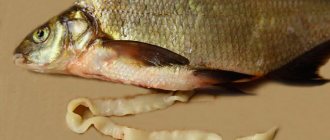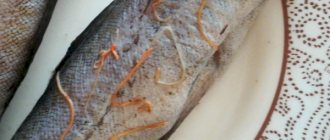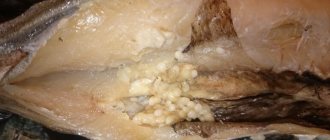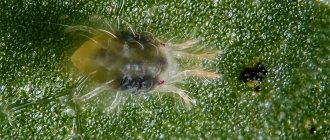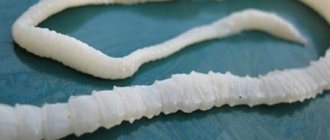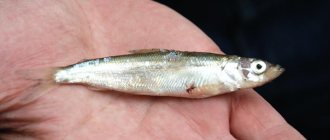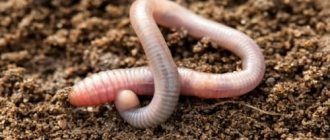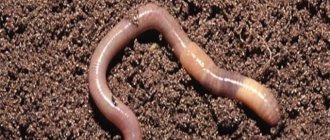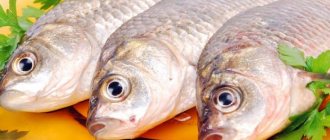Any housewife knows that improper processing of food can lead not only to a deterioration in the taste of the dish, but also to health problems for those who eat this dish. For example, fish often contains various worms, which are quite dangerous for humans to eat.
To avoid unpleasant consequences, you need to know how to determine the presence of parasites and how to properly process and cook fish.
Types of parasites
Various worms can be found in live fish. It is very useful to know what parasites look like, how they can be detected, which of them pose a serious threat to human health, and which are practically harmless.
Wide tapeworm
These helminths are quite common in fish. The parasite belongs to a type of flatworm, a class of tapeworms. It can reach a size of several meters. In fish, it is most often found in the liver or muscles. In the human body it parasitizes in the small intestine. The disease is caused by diphyllobothriasis.
Tapeworm
Cat fluke
The parasite, which belongs to flatworms, begins its development in the body of freshwater snails. Then it leaves the host’s body and, once in a reservoir, enters the fish’s body, where it develops in muscle tissue. Often found in carp, carp, roach, and cod. Once in the human body, it grows, releasing toxins in the process of life, which causes the patient’s immunity to decrease and their general well-being to deteriorate.
Beltworm
Ligulidae is also called tapeworm. This white worm develops in the abdominal cavity of the fish. As it grows, the internal organs of the fish are increasingly compressed, which causes a disruption in their normal functioning.
On a note! Due to damage to the swim bladder, fish often cannot dive into the water and float on the surface.
As a result, the infected individual stops growing. These worms are most often found in pink salmon, bream, and rudd.
Schistocephamos and phylometra
Schistocephamos is a worm from the genus trematodes. This is a small worm, similar in appearance to a tapeworm. Most often they parasitize smelt or crucian carp.
Philometra are thin red worms reaching a length of 10–15 cm. Most often they parasitize on the scales in the head area, under the gills.
These parasites in fish are not dangerous to humans.
Trienophorus nodulosus and Cystidicolafarionis
Trienophorus nodulosus are helminths that live in the liver of fish (most often burbot). Recognizing the parasite is quite simple. The worm itself is 7-8 cm long and lives in a capsule in the form of a small light ball. After careful removal of the liver, the fish is absolutely safe for humans.
Cystidicolafarionis - parasitizes the swim bladder of river fish, such as perch, pike perch, and smelt. During the cleaning process, the fish's innards are removed, after which the product can be eaten without harmful effects on health.
Anisakid
These helminths are nematodes and most often infect marine fish. They can be found both in the body cavity and in muscle tissue, most often in a coiled state. Worm larvae, depending on the species, are yellowish or red in color. Once in the human body, fish worms penetrate the digestive tract, where they attach to the mucous membrane, provoking the development of an inflammatory process.
Safe types of parasites
Some types of worms that parasitize fish do not pose a danger to humans. These varieties include:
- diplostoma (flatworms) - mainly affect the gills, eyes, pectoral fins;
- polymeters (roundworms) - in males they parasitize inside the swim bladder, in females in scaly pockets;
- several types of tapeworms, including the common Ligulidae , a white worm that lives in the stomach of fish.
Worms in fish
These helminths are not parasitic in the human body. Moreover, if the fish is properly cleaned before cooking, all parasites will be removed.
Proper processing of fish products before consumption
It is important to remember that when eating raw fish products, you need to use those species that were grown in artificial reservoirs on an industrial scale. There, during the growing process, future products are constantly monitored and if a danger of infection with helminthic infestations is detected, appropriate measures are immediately taken. Fish caught at sea must also be deep-frozen. Regarding the inhabitants of wild rivers and lakes, it is better to choose finished products that have undergone heavy smoking or long-term salting. Fish dishes can be completely prepared so that they are not dangerous for consumption by boiling or frying, which last for at least 20 - 30 minutes.
The most susceptible fish species to infection
Although any fish can be infected with worms, some species are more susceptible to infestation. For example, parasites are found much more often in river and lake fish. The varieties most susceptible to parasite infestation include:
- crucian carp;
- perch;
- ide;
- bream;
- tench;
- pollock;
- flounder.
Depending on the type of parasite, fish may contain eggs, larvae, or adults. Preparing dishes from fish, which is likely to be contaminated, requires particularly careful cleaning and high-quality heat treatment.
Prevention
Preventive measures against infection are based on proper preparation of the product.
Methods for storing and processing fish:
- Freezing will help get rid of live parasites in 2-4 weeks if the freezer temperature is below 12 °C. The product must be frozen evenly and slowly. Even at temperatures below 25 degrees and quick freezing in the freezer, worm eggs can remain viable.
- Drying and salting. To completely destroy helminths, the brine is prepared at a concentration of 20%. The fish must be kept in liquid for at least 7 days. It is better to salt in small batches. Before drying, the product is salted for 2 weeks; the drying time must be increased to 3 weeks.
- Parasites do not survive heat treatment. It is recommended to boil or fry the product, cutting it into small pieces, for 20-40 minutes. When baking, the cooking time increases to 1 hour. Hot smoking at a temperature of 80 °C lasts 2 hours. When cold smoking with smoke, the fish is pre-salted as for drying. Heat treatment is also necessary when feeding pets.
To cut fish, you need to allocate a separate board, knife and utensils. After the procedure, rinse the accessories well.
What do helminths look like in fish?
Worms that can develop in fish belong to different species, therefore they differ in size, color, and location. It is not always possible to see worms, since sometimes their size reaches only a few millimeters, and they are located in the internal organs, muscles, and gills. The most difficult thing to notice with the naked eye is the larvae, but it is they who pose the greatest danger to humans. Adult helminths most often curl into a spiral or ring.
In order to make sure of the presence of worms, when cutting fish, you need to carefully examine it. But it is not necessary to find the parasites themselves. It is enough to know what fish infected with worms looks like. Most often, the surface of her body is uneven, with bumps and swelling. The color is uneven, with darkening, the eyes are cloudy.
Diseases carried by infected fish
According to research, both red and white fish, even the noblest breeds, can be infected with parasites. If anyone has any doubts about whether worms in fish are dangerous for humans, just read the list of diseases caused by worms:
- diphyllobothriasis - its causative agent, the broad tapeworm, enters the human body at the larval stage, and then develops and lives in the intestines, causing digestive problems;
- clonorchiasis - the disease is caused by Chinese fluke entering the body, the parasites provoke disruption of the liver, pancreas, and bile ducts;
- nanophyetosis - parasites settle in the intestines, exerting toxic-allergic and mechanical effects on its tissues;
- opisthorchiasis - occurs after the Siberian fluke enters the body, over time leading to an enlargement of the liver and spleen;
- Anisakidosis - eggs and larvae of worms, once in the human body, provoke the development of gastrointestinal diseases;
- Metagonimiasis - small worms, parasitizing in the intestines, cause digestive problems, stomach pain, and vomiting.
Stomach pain
If treatment is started in the early stages, the prognosis for all diseases is favorable. The problem is that the symptoms do not appear immediately and are classified as non-specific, which makes diagnosis difficult.
Description and photo of acanthocephala
Acanthocephalans are parasites from the family of spiny-headed worms. Another name for them is acanthocephala. They are quite large and clearly visible on the surface of the fish’s body due to their bright color. The color of the worms ranges from dull orange to orange-red. The body has a characteristic ringing and appears segmented. But in reality, the acanthocephalan is a complete parasite. At the anterior end you can see a proboscis framed with hooks, adapted for fastening in the intestine. If necessary, the proboscis is retracted into the body. Photo:
There are about 500 species of acanthocephalus. Some can reach a length of 70 cm, while others look quite small compared to them.
The most common acanthocephalans found in pollock are:
- Echinorhynchus gadi. Worms, 4-8 cm long.
- Corynosoma strumosum. They have a body length of up to 1.5 cm.
- Bolbosoma. Worm 1-2 cm in size.
Acanthocephalans parasitize the intestines of vertebrates: sea and river fish, birds, pigs, seals, and very rarely in humans. There are only a few confirmed cases of human infection with acanthocephalans. One of them was registered in Brazil in 1921. In a study of 1236 scatological samples, eggs of the giant acanthocephalan were identified in 2 of them, which parasitizes in the intestines of pigs and uses cockchafers as intermediate hosts.
Is it possible to eat fish with worms?
According to existing sanitary standards, fish infected with certain types of helminths is considered conditionally suitable for consumption. This means that if parasites are found in raw fish, it can be eaten after appropriate processing.
On a note! A person will not become infected with worms from well-fried or boiled fish, as they will die from high temperature. The same can be said about well-salted fish; it is almost impossible to become infected with roundworms or other helminths from it.
But no one has canceled such a completely natural feeling as disgust. Not everyone will agree to eat wormy fish, even knowing that it is safe and all the parasites in it have died.
Danger to humans
Sushi lovers, for example, should know that seafood products are also susceptible to helminthiasis, therefore, while enjoying this dish, it is quite possible to become infected with worms. Since sushi does not involve heat treatment, you should either refuse it or take care of the prevention of helminthiases.
Important
be able to determine the presence of worms in meat.
From this point of view, small-sized helminths pose an increased danger. In addition to proper cleaning, sufficient heat treatment is also very important.
How to protect yourself from parasite infection?
Having bought fish even in the most expensive store, you can never know 100% whether there are worms in it. Therefore, to avoid eating food contaminated with parasites, it is necessary to select and process fish correctly.
The following recommendations will help you enjoy deliciously cooked fish and avoid becoming infected with helminths:
- When purchasing, you need to carefully inspect the carcass; you should refuse fish with dark spots on the skin, loose meat, cloudy or missing eyes;
- during cleaning, you should pay special attention to the insides; most often the parasites are localized there;
- to destroy parasites and their eggs, the fish must be heat treated (cook for at least half an hour, fry for at least 20 minutes, bake whole for at least 40 minutes);
- in fish frozen at -20⁰С, parasites die after 2 days, at -4⁰С - within a month;
- When salting, you must use a concentrated salt solution and keep the fish in it for at least 15 days.
Well, of course, it all depends on the degree of infection. If your fish is infested with worms, the only thing to do is to get rid of it as soon as possible without any doubt.
Is it possible to return an item?
Claims regarding the acceptance of defective purchases are accepted only within the expiration date. Please note the following return cases:
- After the expiration date, you can no longer exchange what you purchased..
- If the product is expired , then it should not be in the store. If this does occur, then responsibility for this rests with the store administration.
- A purchased item in normal presentation cannot be exchanged . If the buyer still wants to return the purchase, then this must be done at the checkout.
Here are some tips on how you can get defective goods back:
- replace them with the same one , but with a normal shelf life,
- replace the damaged product with a similar one,
- return the goods, having received the previously deposited funds for them.
It is important to know! If they refuse to return the money to the buyer, but the receipt has been preserved, then they should contact Rospotrebnadzor.
Which fish doesn't have worms?
It is difficult to say for sure which fish are free of parasites, since absolutely all species are susceptible to infection. But there are some categories in which worms are very rare. These include species that live in the open seas or ocean, as well as fish that live in cold waters. Parasites are least often found in the following types of fish:
- sturgeon;
- tuna;
- mackerel;
- catfish
Tuna
You must understand that there are no guarantees and any individual can be infected, regardless of species.
Suppliers of artificially grown fish assure the absolute purity of their products. But whether artificial cultivation guarantees the absence of parasites and how carefully all sanitary conditions are observed in each specific farm is impossible to say for sure.
A little history: why were only pollock backs sold in the USSR?
Historically, people have always treated pollock as a cheap food product. In the USSR, fish was sold everywhere in canteens. But the production of food products was greatly hampered by a speculative campaign that began in Europe in the early 70s. Thanks to television, pollock gained the reputation of being a fish heavily affected by nematodes (worms). There was a serious stir of rejection not only of pollock, but also of cod.
Very soon, studies carried out in European countries showed that the fish is absolutely harmless to human health, even if affected by worms. When frozen, nematodes die within 24 hours. In Europe, opposition to pollock has been reduced to zero. But in the USSR, people for a long time avoided buying products made from it. This forced producers to introduce into circulation the “back” of pollock, devoid of belly and intestines. Only 40% of the whole fish was left, and the rest was sent to waste.
